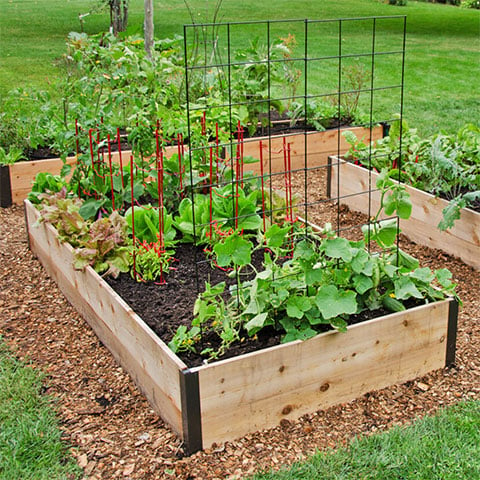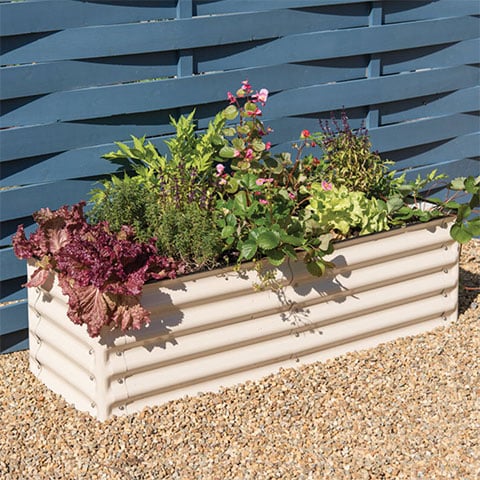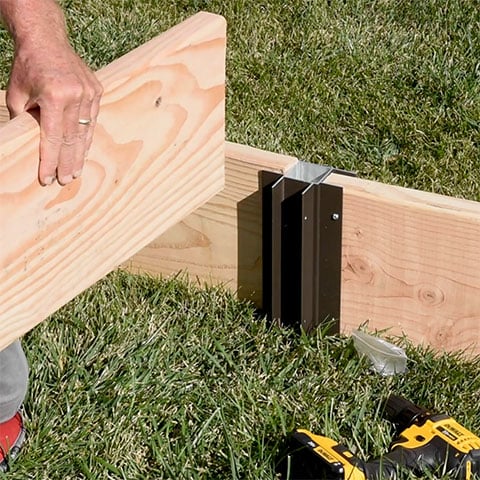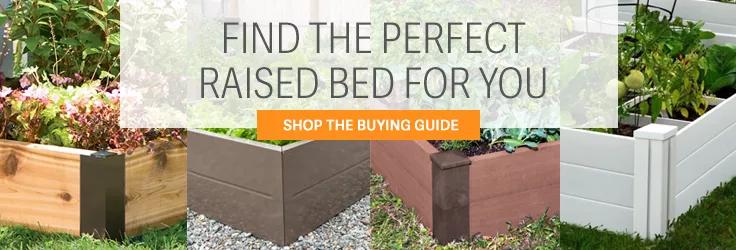Raised Bed Buying Guide
Watch Charlie Nardozzi as he explains the benefits of gardening in raised beds and describes some of Gardener's Supply's raised bed options. Learn more about Charlie.
Starting a new garden? Looking to up your gardening game this year? Try growing in raised beds! They're available in a variety of materials, dimensions, and heights — including waist-high, no-bend elevated gardens — so there's sure to be one right for you. Check out Charlie Nardozzi's video, above, for help choosing from the many options, and find more tips below.
| In this article: |
8 Reasons to Garden in Raised Beds
Here are some of the many benefits to growing in raised beds vs. in-ground beds:
- The soil warms up and dries out faster in spring, so you can start planting earlier.
- You can fill beds with the optimal soil for the plants you're growing. (This is especially important if your soil is heavy clay or very sandy.) Use a mix of topsoil and compost to start plants off right.
- They're more productive. Plants grow faster and produce more.
- They can be used to define a space, helping to keep pets and kids out of the garden.
- Soil stays loose and fluffy because you won't be compacting it by walking in the beds.
- Problems with rabbits and woodchucks nibbling your veggies? Elevated raised beds keep plants out of their reach — and make it easier for you to reach plants without bending or kneeling.
- They're available in a variety of materials, so you'll find beds to complement your home and landscape style.
- They're easier to cover, so you can protect plants from insects and other pests, as well as chilly and/or windy weather.
Factors to Consider When Choosing a Raised Bed
Width. To eliminate soil compaction (important for healthy plants), choose a width that allows you to reach all plants without stepping into the bed. If you can reach plants from both sides, a width of 3' to 4' is best. If access is limited to one side, consider a 2' wide raised bed.
Length. Most beds are between 4' and 8' long, with paths between beds for easy tending. Looking for longer beds? Learn how our Lifetime Raised Bed Corners and In-Line Connectors let you customize your set-up.
Shape. Rectangular beds are the most common, but there are also round beds, square beds, and even beds with rounded corners.
Depth of planting area. A soil depth of 6" to 8" is fine for most vegetables. Large plants, such as tomatoes, as well as shrubs like blueberries, prefer deeper soil, especially if the native soil underneath is poor quality or compacted.
Self-watering options. Our innovative self-watering reservoirs extend time between waterings and create more even moisture throughout the bed. Plants grow better and produce more — and you water less often!
Raised Bed Materials
What is the best material for a raised bed — wood? Metal? Composite? Other?? Well, the answer of course, depends on what you’re growing, your garden style, and your growing zone for starters, but some easy filters for guiding your decision should include longevity, expense, and aesthetics. For a deep dive on these factors and more, check out our Best Materials for Raised Beds article.
Wooden Raised Beds
Wood is a traditional material for raised beds and long-lasting, rot-resistant cedar is both attractive and practical. We offer cedar wood raised beds in a variety of sizes, shapes, an heights, including:
- Complete Raised Beds
- Deep Root Raised Beds
- Elevated Planter Boxes
- Elevated Raised Beds
- Copper Cap Raised Beds
Metal Raised Beds
Metal raised beds are becoming increasingly popular. Recent innovations in long-lasting beds made from powder-coated steel and Corten steel offer additional design options.
- Demeter Raised Beds: Stylish and affordable beds are made from sturdy yet lightweight powder-coated steel.
- Birdies Modular Raised Beds: Birdies premium Australian-made beds are constructed from Aluzinc powder-coated steel. We also offer exclusive, self-watering versions.
- Corten Steel Beds: This long-lasting and durable weathering steel develops a distinctive patina of rust that is both attractive and protective, safeguarding the base metal from corrosion. Explore Birdies and GSC modular beds in Corten steel.
DIY Lifetime Aluminum Corners
Create beds of any size and shape with our rustproof aluminum corners. A longtime customer favorite, the corners shorten building time and result in a handsome, sturdy raised bed every time. Use the In-Line Connectors to add strength and prevent bowing in beds longer than 8 feet. Adjust the pivoting corners to any angle between 90 and 180 degrees. Learn how to build a DIY raised bed: How To Build a Raised Garden Bed
Elevated Raised Beds
Beds that are raised up on legs or tall sides bring plants up to a comfortable working height for easy planting, tending and harvesting. They also minimize problems with nibbling rabbits, woodchucks, and other animal pests.
About video presenter Charlie Nardozzi
For more than 30 years Charlie Nardozzi has been bringing expert gardening information to home gardeners through radio, television, talks, magazines, websites, and tours. Visit Charlie's website and Instagram page.
Print this Article:
Get the Dirt
Stay up to date on new articles and advice. Please fill out the information below.




